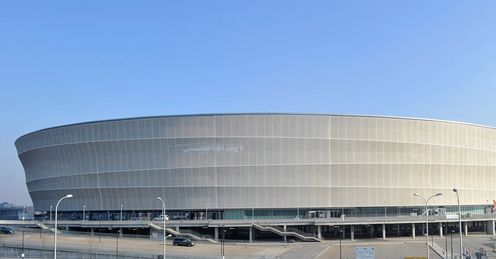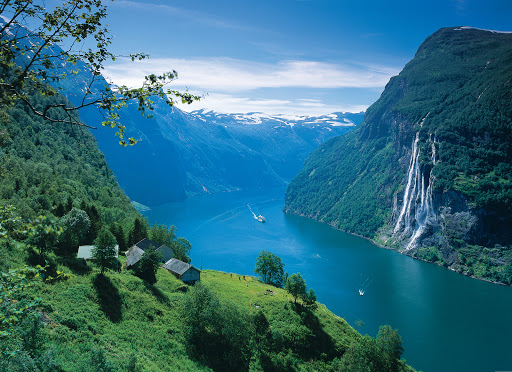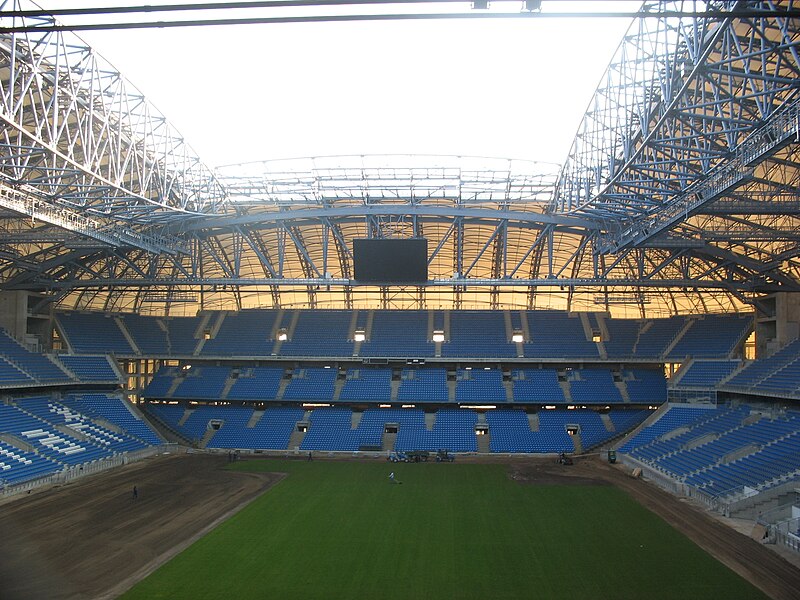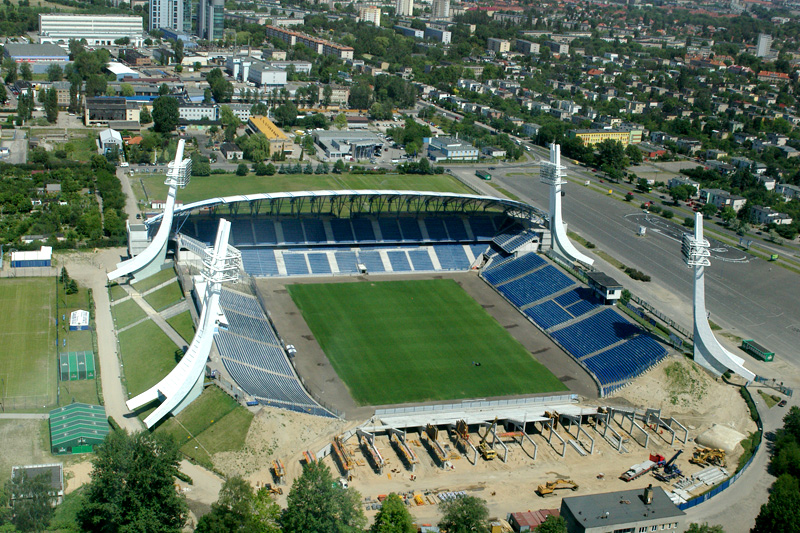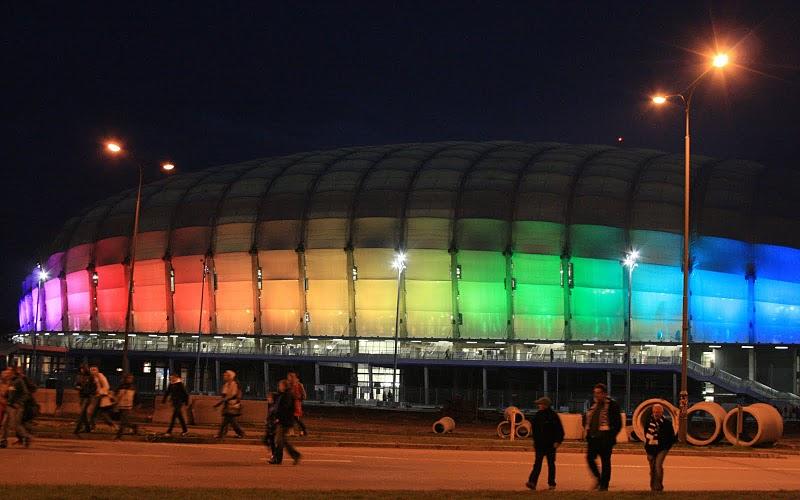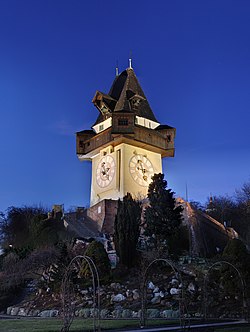Extra-Velganzer. From west to the east. A little bit problem,
but that’s ok. After visiting Arena Lviv, we are going to visit one of the host
city in the eastern of Ukraine and is about 1175 Km. I take this opportunity
just to make sure that our final trip is the stadium that would held the final
game of EURO 2012. Where we heading. Of course you already now. Donetsk. And Donetsk
will be team base camps for France.
First things you have to know about Donetsk is this city is the
centre of Ukraine's coal mining region. South-east of Kyiv on the Kalmius
River, it was founded in 1869 by Welsh businessman John Hughes, who established
a steel mill and several coal mines in the area. A century and a half later and
Donetsk's patrons are still built on foundations of steel and coal, the
industries leaving an indelible mark on the cityscape.
Despite images of soot-caked faces and hob-nailed industry,
the capital of the Donbas has actually been recognised by UNESCO as the world's
cleanest industrial city and the center is benefitting from a financial
injection. Five rivers meander through it and the Sea of Azov, the world's
shallowest sea, is an hour away. But let me tell you another story of this city
in another discussion. Right now, let’s hurry to finish our travel in this city
by visiting the stadium that will be used to live event of EURO 2012.
Yes, Donbass Arena. One of the stadium in the heart of
Donetsk. The Donbass Arena is the new home of FC Shakhtar Donetsk. It has a
capacity of 51,504 seats, which includes 45 corporate boxes that can hold 830
people.The construction of this stadium begun in June 27, 2006. The first story
of this building started when the businessman and club owner Rinat Akhmetov had
raised the profile of the club with his investments, the next step was to be
the construction of a prestigious arena. Construction started in 2006 and was
completed in 2009.
The architect for this stadium is Arusport. Arup
(officially Arup Group Limited) is a multinational professional services
firm headquartered in London, United Kingdom which provides engineering, design,
planning, project management and consulting services for all aspects of the built
environment. The firm is present in Africa, the Americas, Australasia, East
Asia, Europe and the Middle East, and has over 10,000 staff based in 92 offices
across 37 countries. Arup has participated in projects in over 160 countries. That’s
why if you observe the architecture of the stadium you will find how amazing
the stadium. The stadium finished thanks for the help from general contractor
ENKA a Turkish construction conglomerate based in Istanbul Turkey. The construction
cost for this entire stadium is 400 million Dollar (Such a lot of money isn’t
it?).
The name of the
stadium represents the shortened name for the Donets basin industrial region,
hence - Donbas, however the official name in English spells after
the Russian orthography.
So, whats really
interesting about Donbass Arena can be described in Number Fun facts as follow
(Please remember the fun facts about Donbas Arena, who knows when you watch the
live show of EURO 2012 football game there will be quiz you can win with
answering the question):
- The total area of the stadium's glazed facade is 14,283 sq.m.
- 2,482 triple-pane glass units were used for glazing the stadium’s outer façade.
- Over 16 thousand sq.m of vertical surfaces are made of glass, totaling 3,108 heavy-duty panes.
- The underground height of the building is: parking lot area - 12m; dressing rooms - 8m, media space rooms - 4m.
- Height from pitch level to the topmost roof point is 54m.
- The total floor area of all the stadium's levels makes 83,823 sq.m.
- 93% of stands are roof-covered, only 3,800 seats in the bottom tier are not covered.
- 24 first-aid stations (18 permanent ones and 6 mobile ambulance groups).
- 53 fast-food outlets, a fan cafe, 4 Silver bars, 3 restaurants (Diamond, Platinum, Gold), a media cafe and a lounge bar will satisfy any visitor's taste.
- 2,000 lux is the lighting intensity, ensured by 272 high-precision targeting spotlights mounted along the perimeter of the stadium's roof.
- 6,000 ports installed in the stadium for concurrent network connection
- The stadium's video monitoring system comprises 570 CCTV cameras.
- 588 monitors installed throughout the stadium.
- 92 sq.m is the display surface of each of the 2 giant LED screens.
- 267m is the total length of the LED electronic advertising hoardings
- The stadium's logo structure weighs 50 tons, it is 8m high and 14m wide.
- 34 staircases availablethroughout the stadium space.
- 11,978 is the total number of stairs at the stadium. The flights of stairs comprise 4,181 steps.
- The shortest stairway includesonly 22 stairs (the sub-stand space on the arena’s western side). While the longest one is comprised of 240 steps (on the eastern side).
- The longest stairs are nearly 50m-long.
- 35 steps form each aisle in betweenneighbouring blocks.
- 550 heaters aggregately radiate 22 MW of thermal energy.
- Each heater weighs 49 kg.
- The bowl is divided into 24 heated areas.
- The prime cost of heating one spectator seat during the match is about UAH 1.
- The system consumes some 2200-2300 cubic centimetres of gas per hour.
This Arena will be a
venue at the Euro 2012 championships. At the tournament the stadium will host
three group matches, a quarter-final, and a semi-final. The game are France VS
England on June 11, Ukraine VS France on June 15 and England VS Ukraine on June
19.
How
To Get To The Donbass Arena.
If you from ouside Ukraine then you have to take flight to
Ukraine. I suggest that you take flight directly to Donetsk. So you can
immediately arrive in Donetsk Sergey Prokovief International Airport.
The Donbass Arena is located in the central Voroshylovskyi
district, tucked against the northern edge of the city centre. The stadium is
within walking distance of most city centre locations. On its northern side
lies Leninskogo Komsomolo park.
The main railway station lies further north, approximately 6
kilometres. Tram line 1 brings you in 20-25 minutes to the stadium. Get off at
stop Prospekt Mira. Alternatively take trolleybus line 2 and get off at Bely
Lebed shopping mall.
Buses that serve the stadium are line 13, 14, 16, 46a, 46б,
73б, and 77. Your stop is Krytiy Rynok.
If arriving by car, make your way to the city centre and the
main Artema/Artyoma avenue that crosses the city north-south (starting at the
railway station in the north and running all the way to the southern edge of
the city centre). At the altitude of Mira/Myru avenue turn east and you will
find the stadium after one block on your left hand side.
Address: 189e Chelyuskintsev Street, Donetsk 83048













 8:14 PM
8:14 PM
 Unknown
Unknown


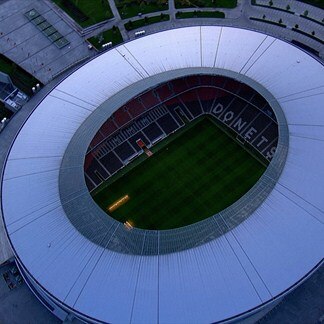


 Posted in:
Posted in: 






